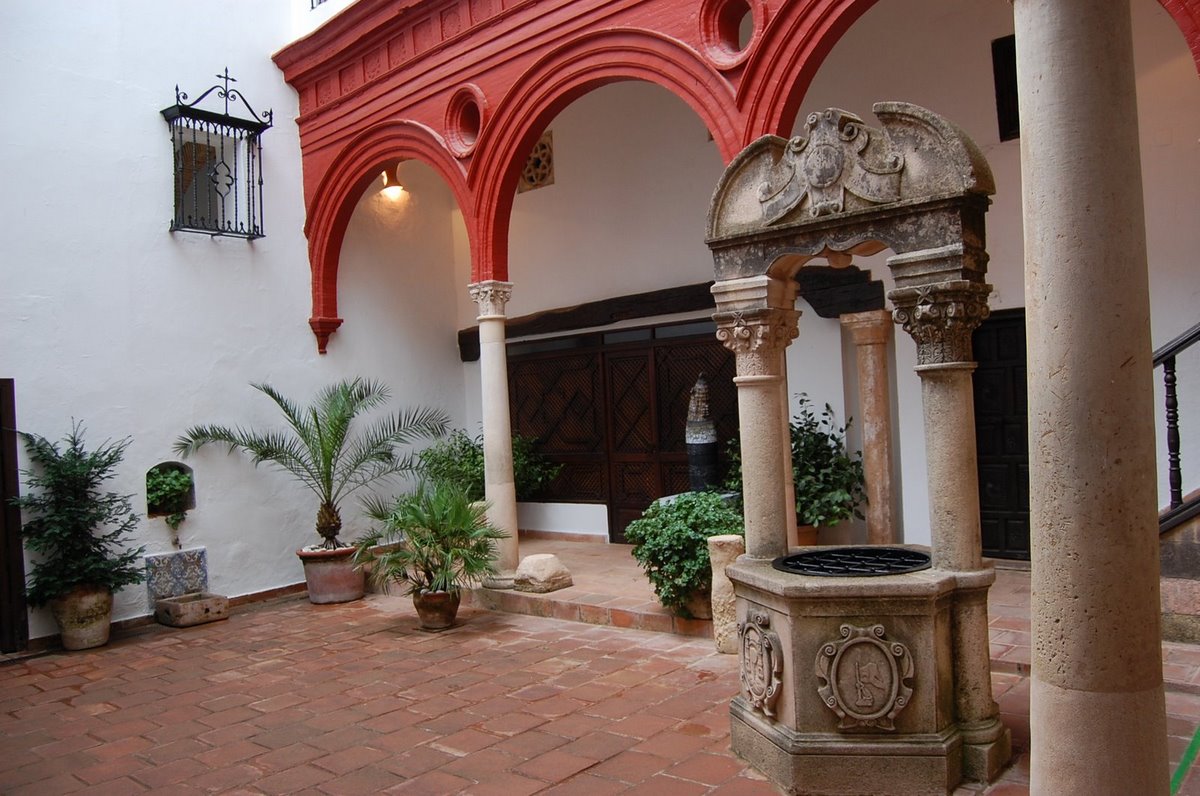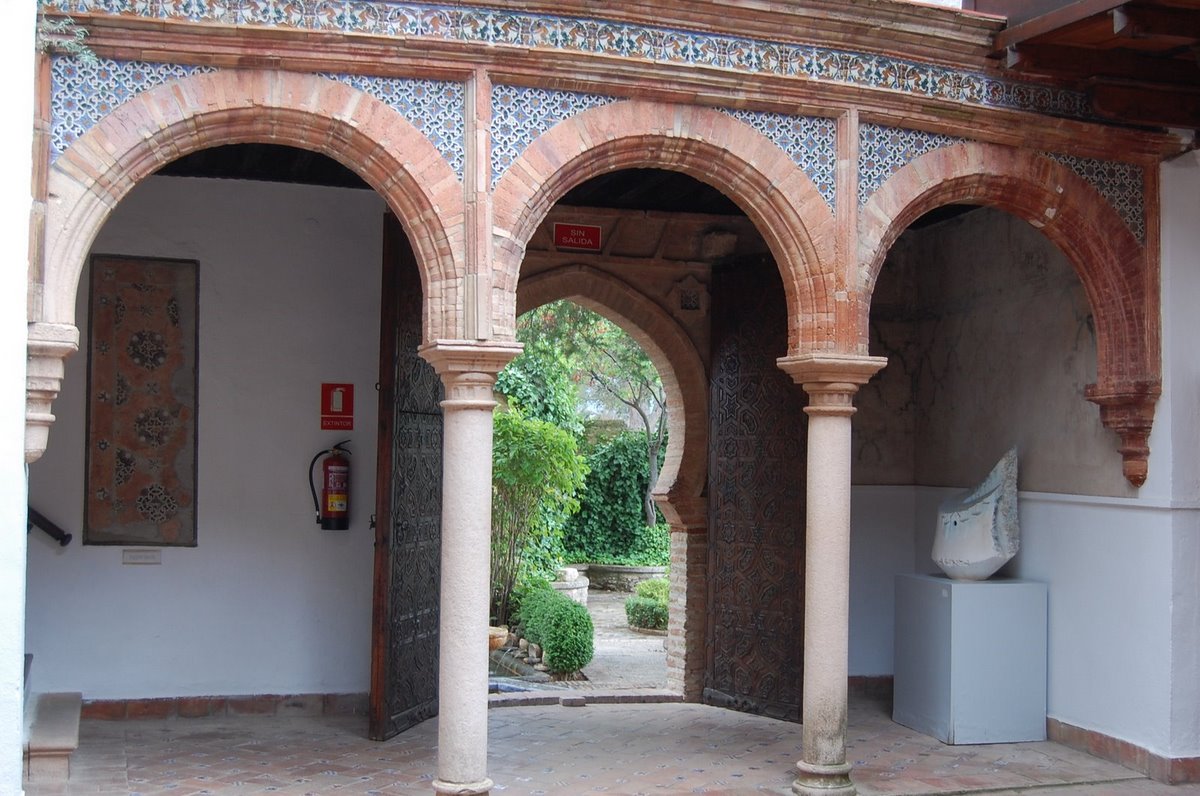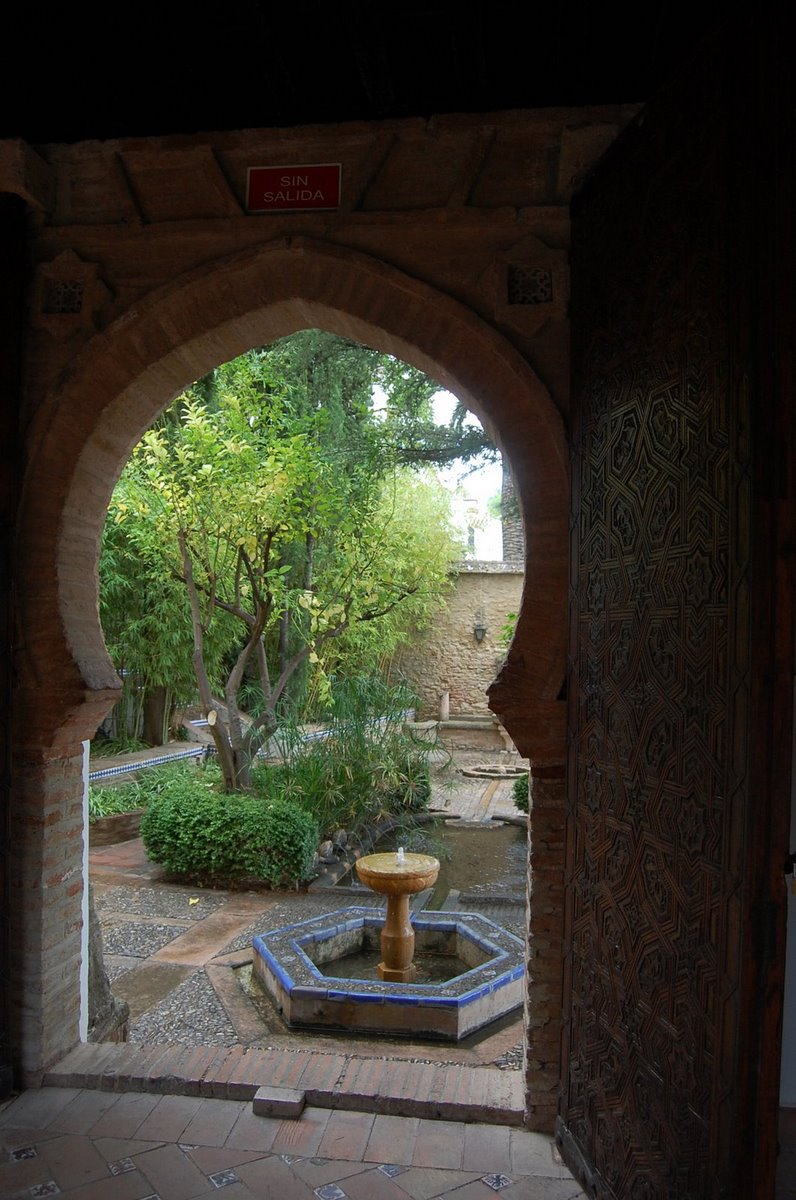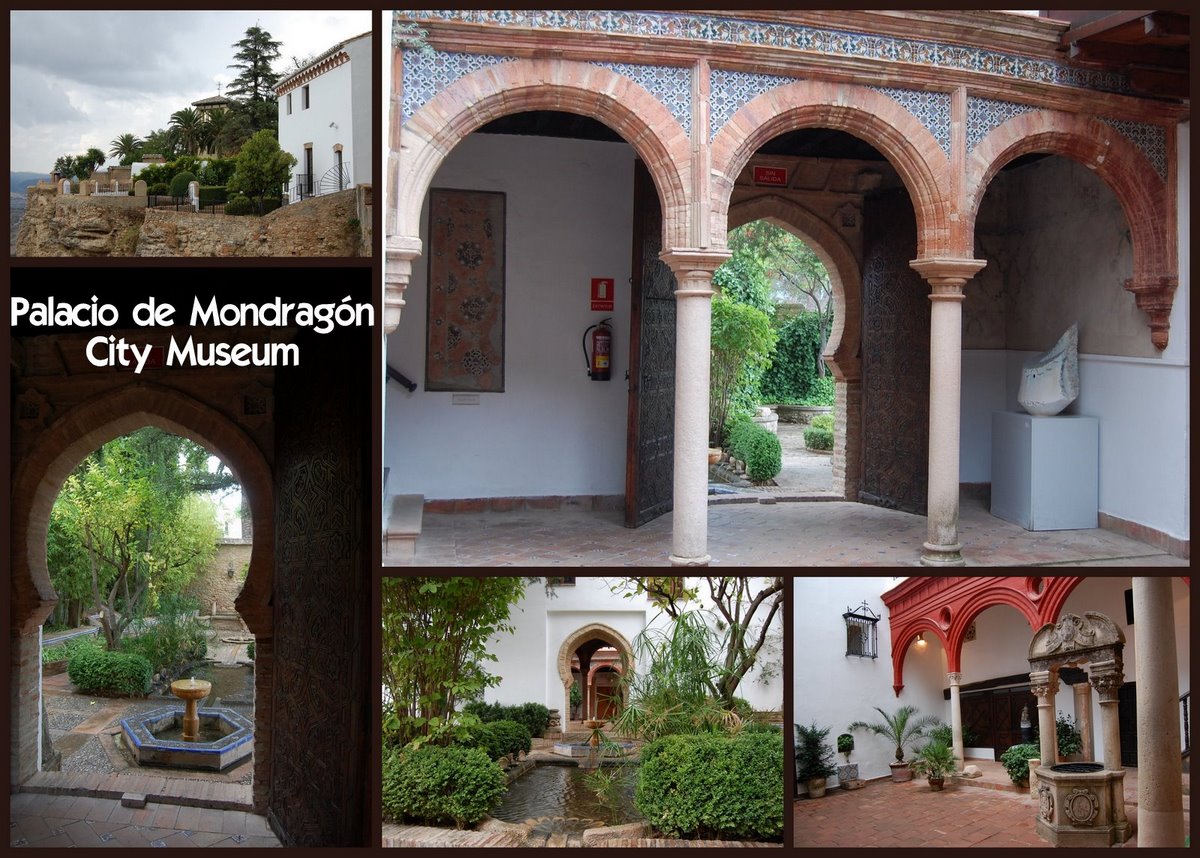Let’s now look at several of the civic buildings
left in Ronda, starting with the city museum which
occupies the Palacio de Mondragón, the former home
of the Arab leaders. It's a 14th century structure
considerably modified in the 16th century after the
Reconquista.
City Museum

This is one of several palaces that cling to the top of
the gulch, el Tajo. Its gardens provide spectacular
views. Inside, the archeological museum displays
artifacts contributed by local humans for millennia.
Displays are extensive and easy to follow in both English
and Español. They recreate Paleolithic and
Neolithic cave life using backdrops, statues, and placing
the artifacts in context.

Although the Arab style dominates, several patios were
added in other styles after the Reconquista.

Today its gardens and patios provide explosions of
color. Inside it’s a museum which explains the
archeology and technology of some of the area’s
ancient inhabitants. This area saw two trading
civilizations vie for dominance mid 1st millennium BC:
The Tartessians traded tin (necessary to make bronze)
perhaps as far away as Britain. They dominated
Andalusia’s long Guadalquivir valley from their
base near the river’s mouth (today’s Cadiz).
Their city disappeared – never to be found –
around 600 BC. In the meantime, the Phoenicians spread
craft, culture, and technology throughout the
Mediterranean. Their collection of city-states was much
more broadly spread and they may have saved city
civilization after it nearly collapsed during the last
thousand years of the Bronze Age.

Above is a traditional Arab water garden. The Moors
would use slaves chained to the rocks to form a bucket
brigade to move water from the stream at the bottom of
the gulch into a water tower at the highest part of the
old city.

A view from the opposite side through one of the
palace's Moorish arches.
Palace of the Marquis of Salvatierra

The small palace of Vasco Martín de Salvatierra,
who ruled Ronda for Ferdinand and Isabel after their 1485
reconquest, was closed (for what seems like a long time);
but its 18th century façade provided a bit of
perhaps unintended comic relief in the stately Ciudad
(the old Moorish city.) It rests near the edge of el Tajo
on a steep slope made slippery as the on-and-off again
rain lubricated these old cobblestones. The iron work
balcony rivals the craftsmanship of the Corinthian
columns and stone reliefs. But would you add a garage
door with its no-parking sign next to such a facade?

You probably recognized the critters holding up the
façade with their heads as caryatids. Baroque
decoration reused this ancient Greek technique (shown
here on an old picture we took of the Erechtheum on
Athens’ Acropolis.) These five are replicas of the
graceful originals. (There were six, but Lord Elgin took
one to decorate his Scottish mansion.) The Greek’s
temple protected a sacred snake.

What we have here is much younger, better preserved, and
a bit more tongue-in-cheek. The guys here (some equipment
lacking) are technically
telamons, not
caryatids. The graceful
flowing robes of their Greek models seem lacking here as
these represent the sculptor’s vision of what
pre-Columbian Native Americans looked like in the buff.
Above it all is emblazoned the coat-of-arms of the
Marquis of Salvatierra who lived here long before this
façade was added.
Casa del Rey Moro

Just down the slippery slope from the Salvatierra palace
was another building which we were not allowed inside
– but the outside had two spectacular attractions
– the gardens of a noted early 20th century French
landscape architect and the ancient tunnel/staircase
built to supply water to the city when under siege.

The place is called Casa del Rey Moro -- the house of
the Moorish king. Legend says it housed king Almonated,
known for drinking wine from the skulls of his enemies.
(Let’s not make the man into a monster, his enemies
were long dead and the wine was probably rated above 95
by Wine Spectator.) In the 20th century, the inhabitants
were somewhat more refined including the Duchess of
Parcent for whom the town’s central park is
named.
Forestier Gardens
The house does not appear very well maintained and
there's rumor that it's on the block and may become a
luxury hotel, but the gardens are well maintained and
superbly designed by Jean-Claude Nicolas Forestier (is
there a better name for a French landscape
architect?)

If you’ve walked through the formal gardens that
culminate in the Eiffel Tower, you’ve experienced
his work in Paris known as the Champ de Mars. We’ll
see more of his work when we share our pictures of
Seville’s parks as well. Here in Ronda in 1912 he
created intimate green geometry with great gorge views
fusing French, Hispanic, and Moorish influences. Note one
of the two towers of the palace at right center.
The tunnel to the river

The other attraction of the home of the Moorish king is
the vertical tunnel built to ensure the water supply if
the town was besieged. Visits require a steep descent
down over 300 slippery stairs -- and then a climb back up
the equivalent of 30 story building.

The “mine” exploited some natural vertical
fissures in the limestone when it was built in the 14th
century. Openings such as this are the only light on the
stairs in many places. Steps are steep and we found many
of them slick with water from the rain which came and
went during our day-long visit.

Large rooms open in a few places (probably these were
natural caves in the limestone). These were converted to
store arms or grain and one of them had access to a well,
complete with a waterwheel. But not all water climbed up
to the old Cuidad that way – slaves carried
up “zagues” – skin jugs. All of
this reminded us of a much more elegant well in what was
then the Italian Papal state of Orvieto where Pope
Clement VII had Renaissance architect Antonio da Sangallo
the Younger secure an uninterruptible water supply with
another mine known as St. Patrick's Well in the 16th
century. See our pictures from our visit to
that double-helix wonder
by clicking here.

At bottom is the prize: the waters of the rio
Guadalevín. Supposedly this mine, when built, was
a military secret. With slave labor to build it and carry
its water over the centuries, its secret would be poorly
kept. Near the end of the Reconquista, the Marquis
de Cádiz attacked on the river and thirsty Ronda
surrendered soon thereafter.
Let’s look at a few more buildings briefly.
Town Hall

Just off a lovely central park named after the Duchess
of Parcent, who built the gardens at the Moorish
King’s house, rises the double-galleried town hall
--very long but quite narrow. Given that the church next
door also contains two tiers of galleries, you might
suspect that the park was once used for bullfights and
these many galleries would shield spectators. Built
in 1734 as a barracks, this building was converted into
shops and a corn exchange (not the same as an open mike
at a comedy club) before becoming the Ayuntamiento.
The Bull Fighting Arena

Above is the entrance to Ronda’s bullring, the
oldest in Spain and while not used much outside of the
Spring festival, still quite important in the history of
bullfighting. The Ronda school of bullfighting school
does nuance, unlike its main competitor, the Seville
school which evolved from the Moors. Ronda started on
foot; Seville on horseback. That gives the bull a bit
more of a chance.
Here Pedro Romero (1754-1839) perfected choreographed
moves based upon his grandfather’s rescue of a
noble by distracting the bull with a cape. Behind these
gates is Spain’s widest bullring – although
all have pretty much the same area unless they are at
high altitude. If so, the ring is smaller so man and
beast do not tire too easily in the reduced oxygen.
The statues here honor another great Ronda family of
matadors, the 20th century Ordóñez dynasty.
Grandpa Antonio alone killed over 1000 bulls and was one
of Hemingway’s and Orson Welles' best friends. (In
fact, Hemingway started to train to be a bullfighter but
gave it up when his skills proved mediocre. Fiction's
gain, but a loss for the bulls who occasionally win one
in the ring. Death in the Afternoon, anyone?)
Today Antonio's grandsons compete in the bullring
tirelessly but perhaps with less art. They make up for
that by modeling for Giorgio Armani. What would
Papa Hemingway say to that
1.
The bandolero museum

Finally we see the quirky museum honoring
Serranía de Ronda’s legendary bandits
(bandoleros). This part of Andalusia is famous for such
rascals who have been romanticized into Robin Hoods.
Bandits in these hills go back pretty much uninterrupted
to at least Roman days when locals complained to Cicero
about them. The bandoleros around this area were
sometimes called cowboys (vaqueros) for their cattle
rustling skills. The phenomenon peaked in the 19th
century after guerrilla fighters no longer had
Napoleon’s troops to fight -- and little chance for
gainful employment. (Hedge funds hadn’t been
invented yet.) Their popularity in the media continues.
What Cervantes featured in “Don Quixote”
continues in picaresque depictions on modern Spanish TV.
Butch Cassidy anyone?
Our final page looks at the town's most important church
built on the foundation of a mosque. Please join us
by clicking here.
Please join us in the following slide show to
give Ronda the viewing it deserves by clicking here.
|
|



















